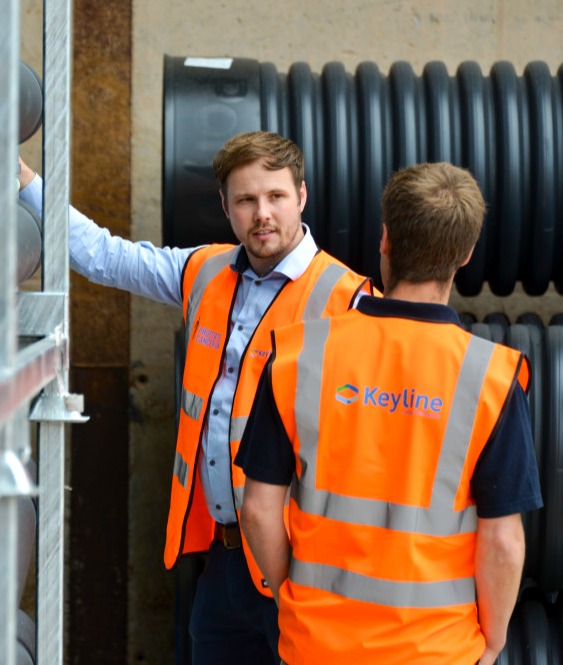How collaboration in the supply chain is the key to improving sustainability in construction & civil engineering
Sustainability is a priority only growing in importance for the construction and civil engineering industry. Contractors, manufacturers and suppliers are constantly looking into ways to reduce their emissions and environmental impact; but working together offers a far more effective strategy than going it alone.
As global awareness of climate change and environmental issues grows, the industry is under increasing pressure to adopt greener environmental practices. Supply chain collaboration offers an answer to the pressing need for sustainable innovation.
A growing priority: sustainability in construction and civil engineering
Sustainability and corporate social responsibility (CSR) are at the core of most company strategies, but their importance is growing each year.
In a bid to prevent the rate of global warming rising over 1.5℃, the UK joined other global powers in signing the Paris Agreement in 2015. The UK took this one step further, becoming the first major economy to make the obligation to reach Net Zero legally binding, committing to end its contribution to global warming by 2050. But it's not just 2050 that has an obligation attached. By 2030, emissions must be reduced from 1990 levels by 68%, and 78% by 2035. The deadline for meeting these targets is looming closer, and sustainability strategies must reflect this.

Global supply chains are responsible for the majority of emissions; some estimates are as high as 90 percent. With supply chain, or Scope 3, emissions accounting for such a significant part of a company's environmental impact, closer collaboration throughout is essential to improving sustainability performance.
What are the benefits of supply chain collaboration for sustainability?
Our industry has a tendency to work in silos, focusing on immediate objectives with a more insular approach to sustainability practices. However, this fragmented approach often leads to inefficiencies, wastage, and missed opportunities for innovation. Looking to your partners can be more effective than looking inward in this regard.
Your company's sustainability effort can be improved without the need for extra work; effective supply chain management and collaboration can make the sustainable approach the easy one, while also saving you time and money. This is how.
Opening the door to sustainable innovation
In the modern world of design, sustainability is always a consideration – but it’s often limited to existing products. You can look through the products available for a viable sustainable alternative, but if you can’t find it, that’s the end of the line.
With early supply chain involvement (ESI), that isn’t necessarily the case. When manufacturers and suppliers are involved at specification, you can create product-based solutions; if a sustainable product doesn’t exist yet, there may be an opportunity to design and manufacture one. Opening discussions and regular rapport with the supply chain is critical to identifying these opportunities.
This approach is highlighted in the Construction Playbook, which encourages “innovative thinking” and “inviting the market to suggest novel solutions to problems”. For architects, specifiers and anyone working on a construction or civil engineering project, ESI presents an opportunity to find the sustainable alternative, even if it requires designing an entirely new product – collaborative relationships with the supply chain, taking advantage of the expertise and capabilities available, opens the door to quick sustainability improvements.
Reduced waste and improved resource management
Closer collaboration within the supply chain leads to greater understanding of project requirements and timelines. Information sharing on inventory levels and close communication throughout a project can help improve efficiency, reducing waste. Deliveries can be optimised to reduce excess ordering and ensure materials are delivered only when needed.
Enabling new approaches: modern methods of construction (MMC)
Supply chain operations are evolving, and manufacturing processes are adapting to new, more sustainable methods. For example, the use of MMC can reduce waste and energy consumption significantly. Off-site construction techniques, such as factory assembly, are an alluring alternative to traditional methods. Innovative manufacturing methods save time and produce high-quality modules.
Clearer insight into Scope 3 emissions
With emissions in the supply chain – or Scope 3 emissions – responsible for much of a company's carbon footprint, it's important to have a clear view of them. Working with your supplier partners to acquire the data needed is essential to establishing a sustainable supply chain.
Collecting data from your supply chain partners helps you identify areas to improve; you can achieve this through training supply chain partners on best practice or switching to a partner that already shows a strong commitment to established sustainability goals.
Regulatory compliance and certification
As governments and international bodies impose stricter environmental regulations, evolving compliance standards becomes a challenging aspect of project specifications.
Supply chain collaborations can streamline the process of meeting regulations such as the Building Safety Act. By working together, companies can ensure that all materials and practices adhere to the required standards, simplifying the process of obtaining necessary certifications and avoiding potential legal issues.
Time savings and cost efficiency
While the initial investment in sustainable practices may be considered prohibitive to some, collaboration in the supply chain often leads to long-term economic benefits.
ESI and technical support from your supplier partner can help you identify and prevent issues at specification. Input from supplier partners is key to more effective designs – their technical advice is essential to reducing changes and costs, and results in faster delivery when construction starts. Efficient resource management, reduced waste, and shared innovation costs contribute to lower overall expenses.
Sustainable supply chains in practice: Birmingham Highways – Keyline Civils Specialist, Kier and Saint-Gobain PAM
An example of effective collaboration in the supply chain is Kier's eight-year Birmingham Highways project. Kier partnered with Keyline for the project, and worked closely to meet their respective sustainability targets.
The team at Keyline were able to suggest viable green alternatives wherever possible, and facilitated communication between contractor and manufacturer – in this case, Kier and Saint-Gobain PAM – to find sustainable solutions.
In this project, sustainable innovation came in the form of non-concrete bollards and a tagging system that makes managing the life cycle of a product straightforward. PAM's innovative tagging system gives clarity on inventory, providing trackable info of when and where they’re installed, and if it’s been installed correctly. You get the full data on the material from cradle to grave.
Another opportunity to address environmental concerns and reduce impact was provided by PAM’s innovative ReCover Ironwork Recycling Initiative. This provides a solution to the end-of-life ironwork that is removed from the highway and replaced (80% of the ductile iron access covers, gully gratings and surface boxes PAM supplies are used to replace a product). The scheme would guarantee complete recyclability, whilst lowering carbon within the supply chain, and is a labelling and tracking system that can be used for future projects.
Keyline’s own operations are designed to be as low emission as possible, improving the sustainability of the wider project. Keyline is a FORS Gold accredited business: the Keyline Birmingham branch uses all-electric forklifts and provides electric car charging provision on site. By working together, and with Keyline acting as a bridge between manufacturer and contractor, innovative, sustainable solutions to challenges were able to be found, and the overall environmental impact of the project reduced.
Steps to foster collaboration
To fully realise the benefits of collaboration in the supply chain, there are easy steps you can take to foster those relationships:
Increase awareness
Many are still unaware of the benefits of working strategically with the supply chain. Or lack awareness that it's an option at all.
Though this is beginning to change, many wouldn’t even think to pick up the phone and discuss a challenge with a supplier partner: raising awareness that the supply chain is a resource for technical expertise that can help you innovate and improve project efficiency is the first step to reaping the benefits.
Encourage open communication
Foster a culture of transparency and open communication with your supplier partner. Regular meetings and opening communication at the very start of projects helps build trust and ensure that all parties are aligned and informed.
Invest in training
Offering training on how best to leverage the expertise of supplier partners most effectively can lead to an increase in collaborative initiatives, ultimately helping foster sustainable innovation.
Leverage technology
At Keyline, Sales Hub is our new and improved Content Relationship Management system, which helps us to engage with our customers early to drive greater value, and make strategic decisions as a team. Digital platforms such as these help to facilitate communication and data-sharing, allowing for real-time collaboration and better decision-making based on accurate and up-to-date information.
Share sustainability goals with partners
Establish clear sustainability goals that all supply chain partners agree on. This shared vision serves as the foundation for collaborative efforts and ensures that everyone is working towards the same objectives.
Improve your project's sustainability with supply chain collaboration
By now you should have greater insight into the importance of supply chain collaboration for sustainability. Closer partnerships can lead to significant environmental and economic benefits, without increasing workload.
For many companies in the construction and civil engineering, the supply chain is an untapped resource. But as the demand for sustainable construction continues to grow, embracing collaboration will be essential for companies looking to reach targets effectively.
To learn more about how we can help improve your project's sustainability, get in touch today.
